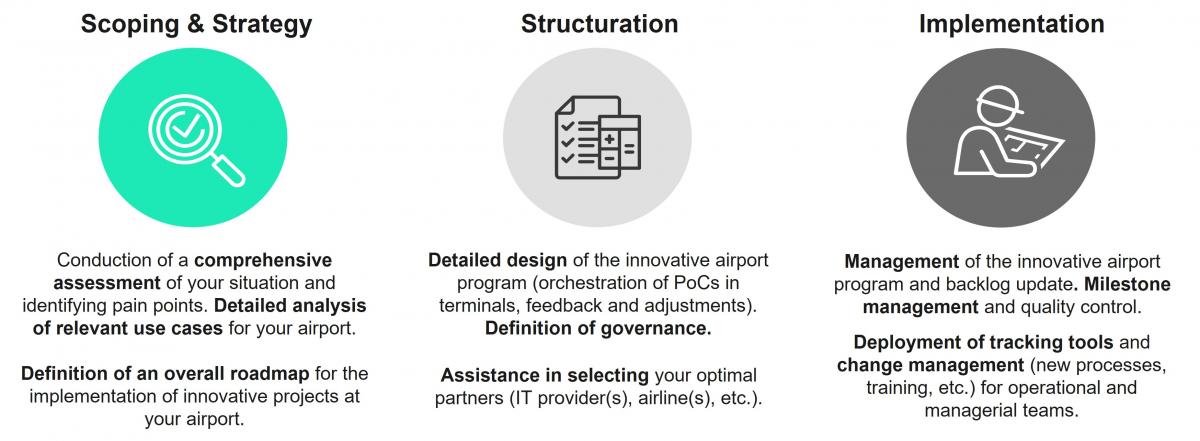Carbon Accounting Management Platform Benchmark…

To meet current development challenges, airports are focusing their strategies on specific topics (biometrics, UAM, digital services, AI, etc.) that we are already supporting our current clients with.
The post-COVID crisis period presented airports with an opportunity to refocus on current development challenges and construct a more innovative and sustainable model. Within this framework, Sia Partners has identified four main pillars driving this transformation. Each of these strategic axes is segmented into use cases that contribute to the trajectory towards the desired ambition.
Achieve Excellence in Passenger Experience
Commit to Sustainable Development
Optimize Operational Performance
Address New Threats
To address the variety of challenges discussed above, airports can rely on a global technological ecosystem. From modernizing the foundational components of the airport to integrating new innovative solutions, here is our macro-vision of the technological levers enabling the response to current development challenges:

Generative AI is a type of artificial intelligence designed to create new and original content based on models and data. This can include images, videos, texts, and even entire virtual worlds.
Our mapping of use cases in the airport sector
We have a range of use cases in the airport sector which we are constantly monitoring.
In addition to our knowledge of specific use cases, Sia Partners has created Sia GPT to support our client's business, using generative AI technology

The management of air and ground operations is fundamental to the purpose of an airport. From control to the optimization of supporting processes, including equipment maintenance, airports have a range of improvement levers at their disposal (lean practices, data science & AI, robotics).
Our vision of innovations to enhance operational efficiency
Robotic operations
Intelligent management systems
Our teams have already experimented with and implemented for our airport clients through our ecosystem of AI solutions, Heka:
Go-To-Gate optimization
Opening of check-in counters
Parking optimization
Customer satisfaction is a crucial factor in the sustainability of airport operations. It should be considered throughout the entire passenger journey, from booking their trip to arrival at the destination.
Regarding contact points within the airport's physical infrastructure, biometric procedures from check-in to boarding offer multiple benefits:
Passenger experience
Non-aeronautical revenues
Operations
Infrastructure management
The challenges involved in deploying these services, identified in our international comparative study (extract at the end of the page):
Urban Air Mobility (UAM) is redefining air mobility with VTOL (Vertical Take Off and Landing) vehicles for a wide range of uses. These services offer a multitude of evolving advantages:
The key challenges in commercial development for an operator
Airports, therefore, have a crucial role to play in the short-term deployment of these services
Why?
Combined with the strong dynamics of this market, airports need to be prepared for an increase in demand from specialist UAM players.
To facilitate quick and informed decision-making, airports will need to have the necessary inputs in terms of strategy for these UAM services. Proven expertise for the Osaka World Expo 2025 (extract at end of the page).
Airports can rely primarily on the key areas of relevance of digital services...

but also take advantage of innovation opportunities (Metaverse, virtual reality...)
Online platform of virtual representation
Interactive AR experiences
VR headsets
Remote-controlled robots
Regulatory initiatives have been taken at all levels: globally with the CORSIA mechanism, in Europe with the "Fit for 55" roadmap, and in France with the National Low Carbon Strategy.
Airports must initiate an energy transition and can rely on various strategies to achieve decarbonization goals:
Focus on the use of SAF in airports (Sustainable Aviation Fuel)
The main goals of this transition
How can airports support the use of SAF?
Sia Partners supports you in your innovative airport projects, from understanding your needs to their implementation

We have a comparative study that decodes the end-to-end biometric pathway development ecosystem and current trends.
We also have a strategic study on the implementation of a UAM service at airports (opportunity studies, analysis of airspace and location possibilities, ConOps etc.).
Our mobile applications benchmark includes over (20+ airports).